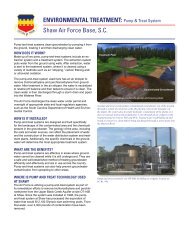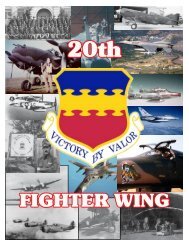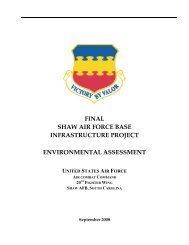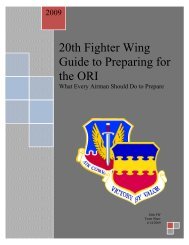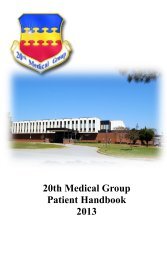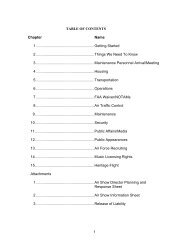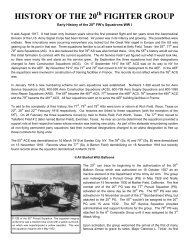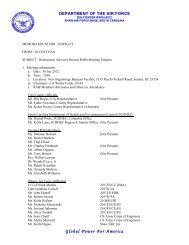HISTORY OF THE 20th FIGHTER WING - Shaw Air Force Base
HISTORY OF THE 20th FIGHTER WING - Shaw Air Force Base
HISTORY OF THE 20th FIGHTER WING - Shaw Air Force Base
You also want an ePaper? Increase the reach of your titles
YUMPU automatically turns print PDFs into web optimized ePapers that Google loves.
P-39D <strong>Air</strong>acobras of the 77 FS Sarasota, Florida<br />
August 1942. Photo from Arthur Harszy<br />
would be transferred out in mass to form a new unit, leaving only a<br />
small cadre behind to start the process over again. This process<br />
is believed to have been used for as many as six new Fighter<br />
Groups. The individual squadrons were stationed at various fields<br />
in South and North Carolina and Florida. While at Wilmington,<br />
the group exchanged its P-40s for P-39 <strong>Air</strong>acobras as part of its<br />
training role. Additionally, the group received P-43 Lancers while<br />
in the Carolinas, also for training purposes. The P-43 was obsolete<br />
at this point and was never on the official record of the group. This<br />
aircraft was the predecessor of the P-47 Thunderbolt. At the end of<br />
September 1942 the group moved to Paine Field, Washington - all<br />
in the latter part of 1942.<br />
In January 1943 the group moved to March Field, California, where<br />
it acquired its P-38 Lightning aircraft. At March the group would<br />
once again proceed with training new members but this time the<br />
results of the training would deploy to England as the 20 FG to write its pages of history.<br />
To Europe in “Luxury” on the Queen Elizabeth<br />
Eight months later, on 11 August 1943, the personnel of the 20 th departed California aboard three trains and<br />
arrived at Camp Miles Standish, Massachusetts, five days later. From this European staging area the members<br />
of the 20 th embarked on the HMS Queen Elizabeth and departed for the United Kingdom on 20 August 1943. If<br />
the members of the 20 th had expected a typical Queen Elizabeth pleasure cruise, they were sorely disappointed.<br />
The ship had been refitted to accommodate over 19,000 men. Staterooms designed for two or three people had<br />
20 to 30 bunks double and triple stacked for officers and enlisted men. In addition to these conditions, enlisted<br />
personnel also served shifts of 24 hours on deck, followed by 24 hours below deck. This doubled the number of<br />
personnel the cramped quarters could accommodate.<br />
Due to its high speed, the HMS Queen Elizabeth traveled unescorted, despite the ever-present threat posed by<br />
German submarines. The five day trip across the Atlantic was reported as uneventful, except for long chow lines<br />
(two meals per day) and frequent boat drills. On 25 August 1943, HMS Queen Elizabeth dropped anchor and the<br />
men of the 20 th disembarked at the Firth of Clyde. From there they were transported to the docks at Greenock,<br />
Scotland, and then, by train, to their new home, King’s Cliffe <strong>Air</strong>field, North Hamptonshire, England. Fortune<br />
smiled on the 55 FS at this time. Due to space restrictions they had to be stationed at RAF Wittering, about five<br />
miles from the rest of the group. The facilities at RAF Wittering were much superior to those at King’s Cliffe. The<br />
55 th Squadron joined the rest of the group at King’s Cliffe in April 1944.<br />
King’s Cliffe<br />
Arriving at King’s Cliffe, the group faced the prospect of operating<br />
from one of the poorest airfields in England. The buildings<br />
were old and inadequate and airfield facilities were close to<br />
nonexistent. The only thing in abundance was poor weather and<br />
mud. Overcoming the initial shock of these conditions the group<br />
soon settled in and got on with the serious job of flying. The group<br />
was assigned to the Eighth <strong>Air</strong> <strong>Force</strong> throughout the war.<br />
Prior to the 20 th ’s arrival in theater, the Republic P-47 Thunderbolt<br />
served as the primary U.S. fighter aircraft in Europe. This aircraft<br />
was a formidable match for the German Luftwaffe (<strong>Air</strong> <strong>Force</strong>)<br />
fighters in air-to-air combat but lacked one important feature-range.<br />
Without sufficient range, the conduct of daytime bomber<br />
20 th Fighter Wing History --- Page Number .<br />
P-38H of the 77 FS in September 1943. Pilots<br />
simulate a “scramble” for this publicity shot as they<br />
wait to fly their first operational mission.



